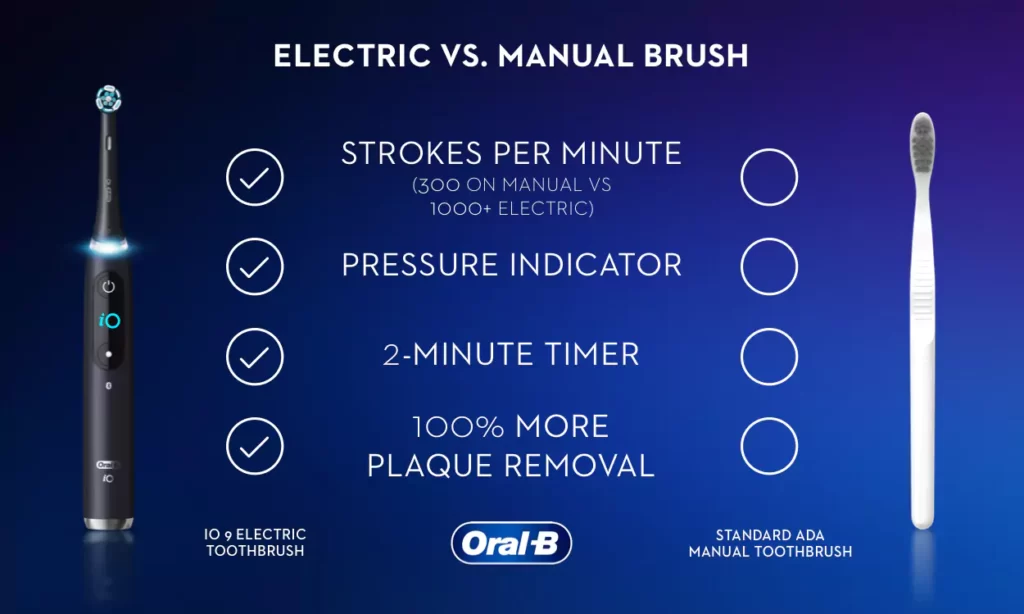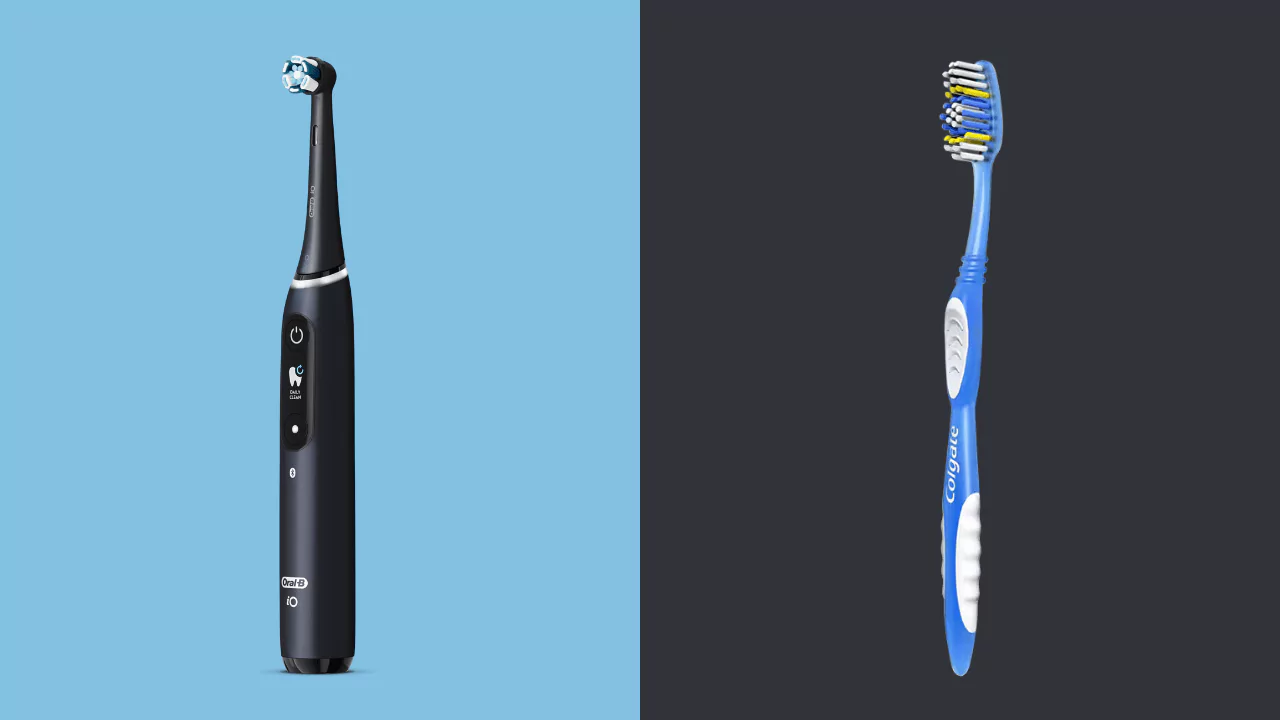Electric toothbrushes are indeed better than manual toothbrushes. Studies have consistently shown that electric toothbrushes are more effective at removing plaque and reducing gingivitis compared to their manual counterparts.
Research indicates that after three months of use, electric toothbrushes reduce plaque by 21% and gingivitis by 11%. Among electric toothbrushes, oscillating (rotating) ones tend to be more effective than vibrating ones.
Dentists widely agree on the superiority of electric toothbrushes due to their ability to reach difficult-to-access areas, where cavities often begin.

What Are Electric Toothbrushes?
An electric toothbrush, also known as a motorized or battery-powered toothbrush, operates by making rapid automatic bristle motions, either back-and-forth oscillation or rotation-oscillation, to clean teeth effectively. These brushes utilize motions at sonic speeds or below, all powered by a motor.
Electric toothbrushes function by rotating in various motions and vibrating against the teeth and gums to aid in plaque removal and reduce gingivitis. Some consider them superior to manual brushes due to their vibration capabilities, which provide micro-movements during brushing.
Electric toothbrushes are typically rechargeable and have a round, smaller brush head. They can have frequencies that range from 200 to 400 Hz, which is 12,000–24,000 oscillations or 24,000–48,000 movements per minute.
Types of Electric Toothbrushes
There are three main types of electric toothbrushes: oscillating-rotating, sonic, and ultrasonic. Each type operates differently and offers unique benefits for dental hygiene.
The oscillating-rotating electric toothbrush features a small round brush head that rotates or oscillates to effectively remove plaque and reach difficult areas of the mouth. This type mimics the tools dentists use for plaque removal.
Sonic toothbrushes operate at high speeds, emitting vibrations and waves ranging from 200 to 400 Hz, or 24,000–48,000 movements per minute. This sweeping motion helps remove plaque more efficiently than other types of toothbrushes.
Ultrasonic toothbrushes are the newest models, utilizing ultrasonic waves at frequencies over 20,000 Hz or 2.4 million movements per minute. These vibrations break up bacterial chains in plaque, preventing them from attaching to teeth.
Electric Toothbrush vs Manual Toothbrush
Differences in Cleaning Effectiveness
Electric toothbrushes use a motor to rotate or vibrate the brush head, creating more movements and pressure than manual brushing. This can help remove more plaque and bacteria from the teeth and gums, especially in hard-to-reach areas. Some electric toothbrushes also have features like timers, pressure sensors, and different modes to help users brush more effectively.
Manual toothbrushes rely on the user’s manual skill and technique to clean the teeth and gums. They can be just as effective as electric toothbrushes if used properly, following the guidelines of brushing for at least two minutes, twice a day, with a soft-bristled brush and fluoride toothpaste. However, many people do not brush long enough, apply too much or too little pressure, or miss some spots when using manual toothbrushes.
Potential Risks of Using Electric Toothbrushes
Electric toothbrushes are generally safe and well-tolerated by most users, but they may pose some risks for certain people or situations. For example, electric toothbrushes may cause more damage to the enamel and gums if used too aggressively or with abrasive toothpaste. They may also interfere with pacemakers or other electronic devices if not used with caution. Electric toothbrushes may not be suitable for children under three years old, people with sensitive teeth or gums, or people with braces or dental implants unless advised by a dentist.
Manual toothbrushes have fewer risks than electric toothbrushes, as they are less likely to cause injury or irritation to the teeth and gums. However, they may still cause problems if used incorrectly, such as brushing too hard, using a worn-out or contaminated brush, or sharing a brush with others.
Benefits of Electric Toothbrushes
Electric toothbrushes have several benefits that may make them more appealing and effective than manual toothbrushes. Some of these benefits are:
- Plaque removal: Electric toothbrushes can remove plaque and bacteria more effectively than manual toothbrushes. The sonic, rotating motions and vibrating bristles can reach areas that are difficult to reach with a manual toothbrush.
- Improved gum health: Electric toothbrushes can clean teeth and gums better than manual toothbrushes.
- Better brushing time: Electric toothbrushes can help you brush for the recommended two minutes, twice a day, which is 30 seconds per quadrant of your mouth.
- Timers: Many electric toothbrushes have built-in timers.
- Easier to use: Electric toothbrushes can be easier for people with limited mobility and fun for kids.
- Better oral health: Electric toothbrushes can help with orthodontic appliances and may improve oral health in people who use them.
- Reduced waste: Electric toothbrushes may cause less waste.
Considerations When Choosing Between Electric and Manual Toothbrushes
When choosing between a manual and an electric toothbrush, you can consider things like:
- Oral health: Electric toothbrushes may be more effective for gum disease or plaque buildup.
- Cost: Soft-bristled manual toothbrushes may be more affordable than electric toothbrushes.
- Ease of use: Electric toothbrushes may be easier to use than manual toothbrushes.
- Cleaning: Electric toothbrushes may be better at removing plaque and bacteria from teeth.
- Brushing time: Electric toothbrushes may have built-in timers to help you brush for the recommended amount of time.
Some say that dentists generally agree that electric toothbrushes are better than manual toothbrushes. This is because the rotation of electric toothbrushes can force toothpaste into areas that are harder to reach, where cavities can start.
Verdict: Which is Better?
There is no definitive answer to which type of toothbrush is better, as both electric and manual toothbrushes can be effective if used properly and consistently. However, some general recommendations from dentists are:
- Electric toothbrushes may be better for people who need more help or motivation to brush their teeth, such as those with dexterity issues, special needs, or poor brushing habits.
- Manual toothbrushes may be better for people who have no problems or preferences with brushing their teeth, such as those with good oral health, good brushing technique, and low budget.
- The most important factors for choosing a toothbrush are the size, shape, and softness of the brush head, the frequency and duration of brushing, and the use of fluoride toothpaste.
- The best way to find out which toothbrush is better for you is to consult your dentist, who can assess your oral health, recommend the best option, and teach you how to use it properly.



